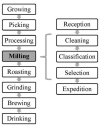Microbial Contamination in the Coffee Industry: An Occupational Menace besides a Food Safety Concern?
- PMID: 36294069
- PMCID: PMC9602572
- DOI: 10.3390/ijerph192013488
Microbial Contamination in the Coffee Industry: An Occupational Menace besides a Food Safety Concern?
Abstract
Respiratory abnormalities among workers at coffee roasting and packaging facilities have already been reported; however, little is known about microbiological contamination inside coffee production facilities. This study intends to assess the microbial contamination (fungi and bacteria) in two coffee industries from Brazil with a multi-approach protocol for sampling and for subsequent analyses using four main sources of samples: filtering respiratory protection devices (FRPD) used by workers, settled dust, electrostatic dust cloths (EDC) and coffee beans. The fungal contamination in the assessed industries was also characterized through the molecular detection of toxigenic species and antifungal resistance. Total bacteria contamination presented the highest values in FRPD collected from both industries (7.45 × 104 CFU·m-2; 1.09 × 104 CFU·m-2). Aspergillus genera was widespread in all the environmental samples collected and sections with clinical relevance (Fumigati) and with toxigenic potential (Nigri and Circumdati) were recovered from FRPD. Circumdati section was observed in 4 mg/mL itraconazole. Sections Circumdati (EDC, coffee beans and settled dust) and Nidulantes (EDC, coffee beans and FRPD) were detected by qPCR. Some of the targeted Aspergillus sections that have been identified microscopically were not detected by qPCR and vice-versa. Overall, this study revealed that microbial contamination is a potential occupational risk in the milling stage and should be tackled when assessing exposure and performing risk assessment. In addition, a multi-sampling campaign should be the approach to follow when assessing microbial contamination and FRPD should be included in this campaign. Occupational exposure to mycotoxins should be considered due to high fungal diversity and contamination. A One Health approach should address these issues in order to prevent consumption of coffee crops and beans infected by fungi and, more specifically, to avoid widespread azole resistance.
Keywords: Aspergillus; One Health approach; azole resistance; milling stage; multi-approach for sampling and analyses.
Conflict of interest statement
There are no conflict of interest to declare. The authors have full control over all primary data and permission is given to the journal to review the data if requested.
Figures






Similar articles
-
Microbial contamination in waste collection: Unveiling this Portuguese occupational exposure scenario.J Environ Manage. 2022 Jul 15;314:115086. doi: 10.1016/j.jenvman.2022.115086. Epub 2022 Apr 25. J Environ Manage. 2022. PMID: 35483278
-
Assessment of Portuguese fitness centers: Bridging the knowledge gap on harmful microbial contamination with focus on fungi.Environ Pollut. 2024 Jun 1;350:123976. doi: 10.1016/j.envpol.2024.123976. Epub 2024 Apr 22. Environ Pollut. 2024. PMID: 38657893
-
Fungal contamination in green coffee beans samples: A public health concern.J Toxicol Environ Health A. 2017;80(13-15):719-728. doi: 10.1080/15287394.2017.1286927. Epub 2017 May 26. J Toxicol Environ Health A. 2017. PMID: 28548622
-
Occupational exposure to Aspergillus section Fumigati: Tackling the knowledge gap in Portugal.Environ Res. 2021 Mar;194:110674. doi: 10.1016/j.envres.2020.110674. Epub 2021 Jan 10. Environ Res. 2021. PMID: 33440201 Review.
-
Aspergillus Species and Their Associated Mycotoxins.Methods Mol Biol. 2017;1542:33-49. doi: 10.1007/978-1-4939-6707-0_3. Methods Mol Biol. 2017. PMID: 27924530 Review.
Cited by
-
Hazards Associated with the Combined Application of Fungicides and Poultry Litter in Agricultural Areas.J Xenobiot. 2024 Jan 9;14(1):110-134. doi: 10.3390/jox14010007. J Xenobiot. 2024. PMID: 38249104 Free PMC article. Review.
-
Antifungal effects of selected menthol and eugenol in vapors on green coffee beans during long-term storage.Heliyon. 2023 Jul 10;9(7):e18138. doi: 10.1016/j.heliyon.2023.e18138. eCollection 2023 Jul. Heliyon. 2023. PMID: 37496903 Free PMC article.
-
Preliminary Investigation on Hygienic-Sanitary Quality of Food Vending Machines.Int J Environ Res Public Health. 2023 Apr 18;20(8):5557. doi: 10.3390/ijerph20085557. Int J Environ Res Public Health. 2023. PMID: 37107839 Free PMC article.
References
-
- ICO International Coffee Organization. 2022. [(accessed on 22 June 2022)]. Available online: https://www.ico.org/
Publication types
MeSH terms
Substances
Grants and funding
LinkOut - more resources
Full Text Sources
Medical

